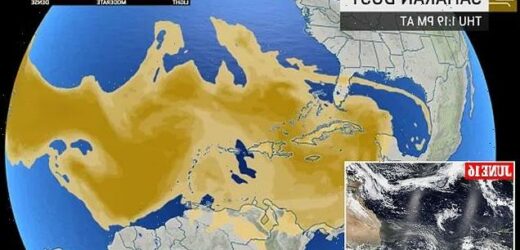Massive Sahara Desert dust cloud that has traveled 5,000 miles toward the US will bring orange skies – and allergies – to Florida TOMORROW
- A Sahara Desert dust cloud is sweeping in across the Atlantic coast that will hit Florida Friday
- It is expected bring stunning sunsets, as 24 tons of dust particles will scatter light in the sky
- The dust cloud will also cause allergies and respiratory issues for some, experts have said
- Another dust cloud made the same path last year that was named ‘Godzilla’ that formed June 14, 2020
A massive Sahara Desert dust cloud is sweeping in across the Atlantic coast, which is set to provide Florida residents with brilliant sunsets to Florida and terrible allergies.
NASA is monitoring the cloud, which was swept off Africa by strong winds swirling across the deserts of Mali and Mauritania, and Bob Smerberck with AccuWeather told DailyMail.com that the plume will hit southern Florida Friday.
‘It is right on the doorstep [of Florida] right now,’ said Smerberck, who is the senior meteorologist.
‘It will shift northward across the state tomorrow and through the weekend.’
The dust plume, which traveled nearly 5,000 miles across the ocean, is expected to dampen storm activity but worsen air pollution, causing trouble for some people with allergies and other respiratory problems, which some health experts say symptoms could mimic those from COVID-19.
However, the plume is carrying 24 tons of dust particles that scatters more light in the sky, producing beautiful red, orange and pink colors in the sky Florida residents.
‘The plume is going to give us beautiful sunsets and sun rises, but on the other hand, it will give you allergies and respiratory issues. It is like a double-edged sword,’ Smerberck said.
Scroll down for video
A massive Sahara Desert dust cloud is sweeping in across the Atlantic coast, which is set to provide Florida residents with brilliant sunsets to Florida and terrible allergies. Pictured is an animation of the plume on June 16
Around this time last year, another desert plume came sweeping across the Atlantic that was so massive, it earned the nickname ‘Godzilla.’
‘Last year was one of the biggest dust clouds in 50 years and stretches the same distances as this year’s, but it went deeper into the US,’ said Smerberck.
‘But we will see how far this one goes.’
Just like the one in June 2020, dry winds carrying the recent cloud could help smother storm systems by drying out the humid tropical air that feeds turbulent weather across a well-traveled route for hurricanes, experts said.
Some parts of the plume in the Caribbean are very thick, according to Smerberck, which is already causing poor visibility in islands such as Cuba.
NASA is monitoring the dust (red), which was swept off Africa by strong winds swirling across the deserts of Mali and Mauritania. Trade winds are carrying the plume across the ocean, with the leading edge expected to arrive in Florida in the coming days
The plume is expected to dampen storm activity but worsen air pollution, causing trouble for some people with allergies and other respiratory problems, and some health experts say symptoms could mimic those from COVID-19. Meteorologists are watching the plume closely and pictured is a prediction for Friday, June 18
Just like the one in June 2020, dry winds carrying the recent cloud could help smother storm systems by drying out the humid tropical air that feeds turbulent weather across a well-traveled route for hurricanes, experts said
However, there is also a disturbance in the Gulf of Mexico that could cut off the dust cloud as it attempts to travel further north.
‘We are in prime time right now for these dust system and looks like it will continue,’ Smerberck said.
‘Last year there was a lot of tropical activity of African easterly waves, which gives more chances for these winds that carry the dust.
‘Right now it looks pretty busy. There is a similarity this year as last year and it may be an above average but that can change.’
A recent study identified Godzilla’s path last year and it could be a similar route taken by this year’s dust plume.
African easterly jets carried it to the Atlantic where it was handed off to the North Atlantic Subtropical High, which then transported it towards the Caribbean region.
‘Once the dust reaches the Caribbean region, the Caribbean low-level jet — that’s another system — along with the subtropical high can further transport the dust from Caribbean region towards the State,’ said the study’s lead author, Bing Pu, assistant professor of geography & atmospheric sciences at KU, in a statement regarding the study.
Data of the current dust cloud showed that on Wednesday, June 16, Florida residents were already experiencing poor air quality.
Trade winds are carrying the dust nearly 5,000 miles across the ocean, with the leading edge expected to arrive in Florida in the coming days
Just like the one in June 2020, dry winds carrying the recent cloud could help smother storm systems by drying out the humid tropical air that feeds turbulent weather across a well-traveled route for hurricanes, experts said
Data showed that on Wednesday, June 16, Florida residents were already experiencing poor air quality
Scientists and health experts have long monitored the plumes for their effect on weather, the climate and the oceans, but it is unclear how severely the incoming plume of dust will affect human health.
‘Those patients are dragging with them some level of damage to their lungs and this dust storm could very well exacerbate their symptoms,’ Orlando Health pulmonologist Dr. Herman Gaztambide, told Wesh 2.
‘When you have COVID-19 infection, it’s an active infection, so you are expected to have a fever with it which is very different than allergies which would give you almost every other symptom, but allergies can never give you fever.
When the plume makes its way over Florida, skies will become hazy due to the tiny dust particles, resulting in enhanced sunsets in the Sunshine state.
The 2020 dust storm was record-breaking event that formed on June 14 and reigned terror on the Atlantic until June 28.
According to NOAA’s Atlantic Oceanographic and Meteorological Laboratory, the dust plume was somewhere between 60 to 70 percent heavier than average, making it the dustiest event since records began around 20 years ago.
Source: Read Full Article









